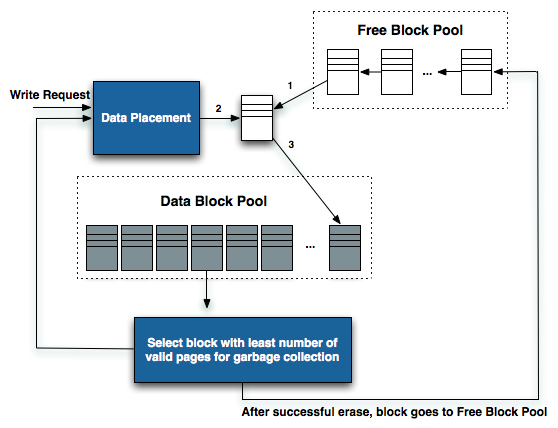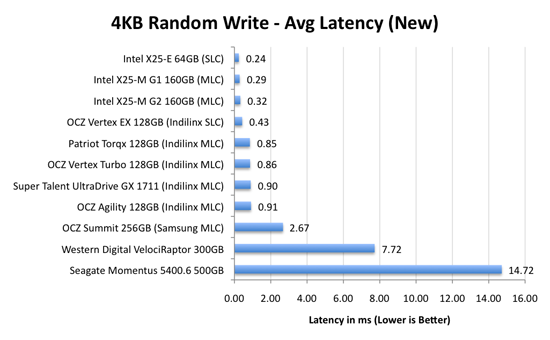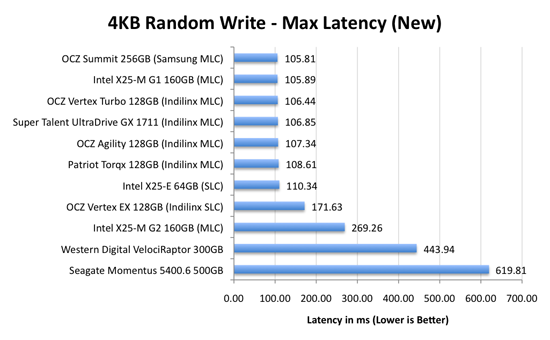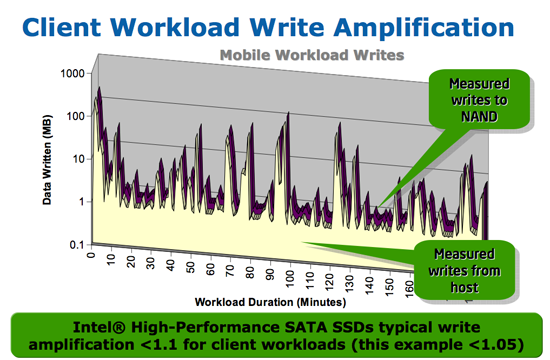The SSD Relapse: Understanding and Choosing the Best SSD
by Anand Lal Shimpi on August 30, 2009 12:00 AM EST- Posted in
- Storage
The Cleaning Lady and Write Amplification
Imagine you’re running a cafeteria. This is the real world and your cafeteria has a finite number of plates, say 200 for the entire cafeteria. Your cafeteria is open for dinner and over the course of the night you may serve a total of 1000 people. The number of guests outnumbers the total number of plates 5-to-1, thankfully they don’t all eat at once.
You’ve got a dishwasher who cleans the dirty dishes as the tables are bussed and then puts them in a pile of clean dishes for the servers to use as new diners arrive.
Pretty basic, right? That’s how an SSD works.
Remember the rules: you can read from and write to pages, but you must erase entire blocks at a time. If a block is full of invalid pages (files that have been overwritten at the file system level for example), it must be erased before it can be written to.
All SSDs have a dishwasher of sorts, except instead of cleaning dishes, its job is to clean NAND blocks and prep them for use. The cleaning algorithms don’t really kick in when the drive is new, but put a few days, weeks or months of use on the drive and cleaning will become a regular part of its routine.
Remember this picture?

It (roughly) describes what happens when you go to write a page of data to a block that’s full of both valid and invalid pages.
In actuality the write happens more like this. A new block is allocated, valid data is copied to the new block (including the data you wish to write), the old block is sent for cleaning and emerges completely wiped. The old block is added to the pool of empty blocks. As the controller needs them, blocks are pulled from this pool, used, and the old blocks are recycled in here.
IBM's Zurich Research Laboratory actually made a wonderful diagram of how this works, but it's a bit more complicated than I need it to be for my example here today so I've remade the diagram and simplified it a bit:

The diagram explains what I just outlined above. A write request comes in, a new block is allocated and used then added to the list of used blocks. The blocks with the least amount of valid data (or the most invalid data) are scheduled for garbage collection, cleaned and added to the free block pool.
We can actually see this in action if we look at write latencies:

Average write latencies for writing to an SSD, even with random data, are extremely low. But take a look at the max latencies:

While average latencies are very low, the max latencies are around 350x higher. They are still low compared to a mechanical hard disk, but what's going on to make the max latency so high? All of the cleaning and reorganization I've been talking about. It rarely makes a noticeable impact on performance (hence the ultra low average latencies), but this is an example of happening.
And this is where write amplification comes in.

In the diagram above we see another angle on what happens when a write comes in. A free block is used (when available) for the incoming write. That's not the only write that happens however, eventually you have to perform some garbage collection so you don't run out of free blocks. The block with the most invalid data is selected for cleaning; its data is copied to another block, after which the previous block is erased and added to the free block pool. In the diagram above you'll see the size of our write request on the left, but on the very right you'll see how much data was actually written when you take into account garbage collection. This inequality is called write amplification.

Intel claims very low write amplification on its drives, although over the lifespan of your drive a < 1.1 factor seems highly unlikely
The write amplification factor is the amount of data the SSD controller has to write in relation to the amount of data that the host controller wants to write. A write amplification factor of 1 is perfect, it means you wanted to write 1MB and the SSD’s controller wrote 1MB. A write amplification factor greater than 1 isn't desirable, but an unfortunate fact of life. The higher your write amplification, the quicker your drive will die and the lower its performance will be. Write amplification, bad.










295 Comments
View All Comments
tachi1247 - Friday, September 18, 2009 - link
Does anyone know what the difference is between the 7mm thick and 9.5mm thick drives?http://download.intel.com/design/flash/nand/mainst...">http://download.intel.com/design/flash/nand/mainst...
They seem to be identical except for the drive thickness.
dszc - Saturday, September 12, 2009 - link
FANTASTIC series of articles. Kudos! They go a long way toward satisfying my intellectual curiosity.But now it is time to reap the rewards of this technology and earn a living.
So I need some real-world HELP.
How do I clone my 320GB (80GB used) Hitachi OS drive (Vista 32 SP2) over to a 128GB Indilinx Torqx?
All I really care about is Photoshop and Bridge CS4 performance. I am a pro and work 4-16 hours per day in Bridge and Photoshop, with tens of thousands of images, including 500MB - 2GB layered TIFFs. The Photoshop Scratch Disk and Bridge and CameraRaw Cache performance are killing me. Solid State Storage seems to be the perfect solution to my problem
I really want to simply clone my 320 over to the Torqx, because it would take me a week to re-install and configure all of my software and settings that are now on the 320GB Hitachi.
Do I just bring the Torqx up in the Vista Storage Disk Management, initialize it with one big partition, and then format it?
What size allocation unit should I use? :
Default? 4096? 64k? ???
Will these settings be wiped out when I clone over the stuff from the old hard drive?
What about "alignment"?
What is the best software for a SIMPLE & painless clone procedure?
I'm not a techie or geek, but have a fair working knowledge of computers.
Any help would be hugely appreciated. Thanks.
userwhat - Thursday, September 17, 2009 - link
I use Drive Snapshot for all these purposes. It works 100%, it´s a very small and fast program. After having issues with Norton Ghost and some other similar programs which were absolutely unable to restore an imaged partition stored on a DVD this is THE one to use.Get it here: http://www.drivesnapshot.de/en/">http://www.drivesnapshot.de/en/
dszc - Saturday, September 26, 2009 - link
Thank you very much for your help and recommendations.To get my Patriot (SolidStateStorage) up and running, I used Seagate DiskWizard (an Acronis subset), as I have lots of Seagate drives already on my system and this free software seems to work.
When I get a window of time in my schedule, I'll try DriveSnapShot and/or DriveImage to see if they do a better job in helping my Torqx SSS run at its full potential.
Thanks again for your help.
Dave
JakFrost - Tuesday, September 15, 2009 - link
If you want to image out your current drive and migrate over to an SSD you can use the free software below that works with Windows Volume Shadow Copies to do a online live migration to another drive without losing or corrupting your data. This means that you can do this from the same OS that you are running.This software will allow you to image out to an already created partition that is already aligned at the 1MB boundry that is standard for Microsoft Vista/7 operating systems.
DriveImage XML V2.11
English (1.78MB)
Image and Backup logical Drives and Partitions
Price: Private Edition Free - Commercial Edition - Buy Now Go!
System Requirements: Pentium Processor - 256 MB RAM
Windows XP, 2003, Vista, or Windows 7
An alternative is to use an offline migration system such as Acronis TrueImage, Norton Ghost, etc. to do the migration offline from a bootable CD or USB drive. Search around for Hiren's BootCD to check out these and other tools to do the migration.
dszc - Saturday, September 26, 2009 - link
Thank you very much for your help and recommendations.To get my Patriot (SolidStateStorage) up and running, I used Seagate DiskWizard (an Acronis subset), as I have lots of Seagate drives already on my system and this free software seems to work.
When I get a window of time in my schedule, I'll try DriveImage and/or DriveSnapShot to see if they do a better job in helping my Torqx SSS run at its full potential.
Thanks again for your help.
Dave
jgehrcke - Friday, September 11, 2009 - link
Be careful when buying a Super Talent UltraDrive GX 128 GB with "XXXX" in serial number (unfortunately you cannot check this before ordering the drive). These drives are much slower than measured in the benchmark here and in other benchmarks.For more information and related links see
http://gehrcke.de/2009/09/performance-issue-with-n...">http://gehrcke.de/2009/09/performance-i...est-supe...
Kitohru - Thursday, September 10, 2009 - link
Does OS X Snow Leopard have trim support, and if not any word from apple about that or the like?Zool - Thursday, September 10, 2009 - link
I still dont think that with this price ssd-s will be more mainstream in the next years. And honestly the performance is not even that extra if everything would work like it should. The mechanical drives can reach now 100 MB reads when things are optimal. The small files performance is still only software problem. U should never ever reach point when u need to randomly find 4 KB files in a long row. With todays ram capacity and cpus-s programs should never read such small files or group things in larger files and read whole to memmory. A solid today programed aplication (let it be game or programs) should never let your disk spam with 30k files (like catia or other plenty of aged so called "profesional" programs). With today ram and disk capacity it should read things to memmory and let only grouped larger files on disk and never ever touch the hdd again until users isnt comunicating with the software (u can tell it to windows).Saves can be made to memmory and than write to disk without even seeing a fps drop in games(not just games) becouse of disk comunication latenciI dont even think the IO performance would be a problem with the RIGHT software and OS. With 100MB reads it could run perfectly fine with few seconds loading times. Even the latencies of ssd-s are no match to ram latencies so everithing that should activly comunicate with disks (which is just stupid with curent ram prices and 64bit) would just level your latencies down to disks.
Why should worry about latencies and read speeds when u could copy it to ram and keep the files on disk in shape where the mechanical drive
should never find itself to read files smaller than few MB.(even your
small txt documents u can hide in archive).
Just my toughs. (sorry for my english)
AlExAkE - Wednesday, September 9, 2009 - link
Hey, I'm a web & multimedia designer. I spend lots of my time using most of the Adobe CS4 products including Photoshop, Flash, Dreamweaver, Illustrator, After Effects & Premiere Pro.The Intel 80GB G2 looks amazing, but the Photoshop test is awful because of his write speed. The Intel 25-Extreme series seem to be the best but is to pricey. The OCZ Vertex has good write speed but is slower than Intel G2 in most of the test. What would be the recommended SSD for my purpose. Thanks